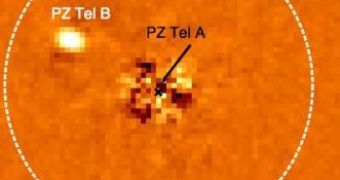A recent discovery brightens astronomers' day as they spotted a brown dwarf tightly orbiting a young sun-like star. This discovery was made possible by the Near-Infrared Coronagraphic Imager, or NICI, on the international 8-meter Gemini-South Telescope in Chile and the lucky finders are part of a team led by University of Hawaii astronomers Beth Biller and Michael Liu along with University of Arizona astronomer Laird Close and graduate students Eric Nielsen, Andy Skemer and Jared Males.
This discovery is very exciting as the proximity between the 36 Jupiter-mass brown dwarf PZ Tel B and its primary star named PZ Tel A is very high - only 18 Astronomical Units, similar to the distance between Uranus and the sun. Generally young brown dwarfs are separated by their stars by at least 50 AUs, more that the orbit of Pluto (40 AUs).
This brown dwarf also moves quickly outward from its star, as astronomers observed in the past year. In an older image taken by Laird Close, a professor at University of Arizona's Steward Observatory and the department of astronomy, PZ Tel B was obscured by the glare from its star, which indicated that its orbit was more elliptical than circular.
Close said that “Because PZ Tel A is a rare star being both close and very young, it had been imaged several times in the past. So we were quite surprised to see a new companion around what was thought to be a single star.”
Lead author Beth Biller added that “PZ Tel B travels on a particularly eccentric orbit – in the last 10 years, we have literally watched it careen through its inner solar system. This can best be explained by a highly eccentric, or oval-shaped, orbit.”
The star - PZ Tel A, is a younger version of the sun, with almost the same mass but about 400 times younger, as it is only 12 million years old. The PZ Tel system is so young that it still has serious quantities of cold circumstellar dust, and this is exactly what makes it very important for studying the early stages of the formation of solar systems.
PZ Tel B being very close to its star, scientists need special techniques and technology to separate the faint light of the dwarf from the light of the star. The team uses an adaptive optics system that blocks out the extra starlight thanks to a coronagraph. Then they use a special analysis method to find the PZ Tel B and measure its orbital motion.
Michael Liu, the NICI campaign leader, said: “We are just beginning to glean the many configurations of solar systems around stars like the sun. The unique capabilities of NICI provide us with a powerful tool for studying their constituents using direct imaging.”

 14 DAY TRIAL //
14 DAY TRIAL //